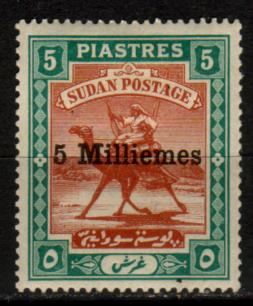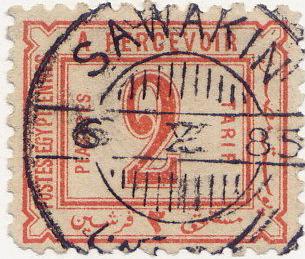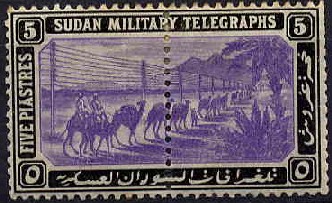 |
|||||
|
|||||
| Preview of Stamps Catalogue: VOLUME 1 |
 |
|||||
|
|||||
| Preview of Stamps Catalogue: VOLUME 1 |
Note: on my website many of the
pictures can not be seen! They are of course present in the catalogue;
contact me if you want to purchase it.
From 1870 to 1897 the stamps of Egypt were used in Sudan.
1 m brown 2 m green 3 m orange 5 m red 1 Pi blue 2 Pi orange 5 Pi grey 10 Pi lilac
The overprint was performed in such a way, that six slightly different types exist.

This strip apparently contains the six different types.
Value of the stamps |
|||
vc = very common c = common * = not so common ** = uncommon |
*** = very uncommon R = rare RR = very rare RRR = extremely rare |
||
| Value | Unused | Used | Remarks |
| 1 m | c | c | |
| 2 m | c | * | |
| 3 m | c | * | |
| 5 m | * | * | |
| 1 Pi | * | * | |
| 2 Pi | *** | *** | |
| 5 Pi | *** | *** | |
| 10 Pi | *** | *** | |
ATTENTION: many forgeries exist! It seems that forged overprint are more numerous than genuine ones. Examples of forged overprints (I'm not sure if all the above stamps are genuine):



(Forgeries, reduced sizes)

The overprint was forged by the forger Fournier.
Here a page from a Fournier Album with two of these forgeries.
1 m red and brown 2 m brown and green 3 m green and violet 4 m brown and red 4 m brown and blue (1906) 5 m black and red 1 Pi brown and blue 2 Pi blue and black 2 Pi orange and lilac (1921) 3 Pi blue and brown 4 Pi black and blue 5 Pi green and brown 6 Pi black and blue 8 Pi black and green 10 Pi violet and black 20 Pi blue (1935)
These stamps have perforation 14.
Value of the stamps |
|||
vc = very common c = common * = not so common ** = uncommon |
*** = very uncommon R = rare RR = very rare RRR = extremely rare |
||
| Value | Unused | Used | Remarks |
| Watermark 'Rose' (1898) | |||
| 1 m | * | * | |
| 2 m | ** | ** | |
| 3 m | ** | ** | |
| 5 m | * | * | |
| 1 Pi | *** | *** | |
| 2 Pi blue and black | *** | *** | |
| 5 Pi | *** | *** | |
| 10 Pi | R | *** | |
| Watermark 'Moons and stars' (1903) | |||
| 1 m | * | * | |
| 2 m | ** | * | |
| 3 m | ** | * | |
| 4 m brown and red | ** | ** | |
| 4 m brown and blue | * | * | |
| 5 m | ** | c | |
| 1 Pi | ** | * | |
| 2 Pi blue and black | *** | * | |
| 2 Pi orange and lilac | ** | * | |
| 5 Pi | *** | * | |
| 10 Pi | *** | * | |
| Watermark 'SG' (1927) | |||
| 2 Pi orange and lilac | * | * | |
| 5 Pi | *** | * | |
| 10 Pi | *** | ** | |
Surcharged

'5 Milliemes' on 5 Pi green and brown (1903)
Value of the stamps |
|||
vc = very common c = common * = not so common ** = uncommon |
*** = very uncommon R = rare RR = very rare RRR = extremely rare |
||
| Value | Unused | Used | Remarks |
| Watermark 'Rose' | |||
| 5 m on 5 Pi | *** | *** | |
I have seen forgeries of these stamps. Forgery with no watermark:
Note the very strange perforation, consisting of small holes with a large space in between (present on all the forgeries of this type that I have seen). The cancel reads "IMITATION"; it appears to be a product of the stamp forger Kamigata from Japan.
Envelope cut in the same design, 5 m red:

More values were issued after 1929. This design re-appeared in 1948 with 'SUDAN STAMP JUBILEE 1989-1948' on top and arabic inscription at the bottom. Also in 1948 this design was again used for the 'OPENING OF THE LEGISLATIVE ASSEMBLY DECEMBER 1948'. In a slightly different design it was used again in 1954 (with inscription 'SELF GOVERNMENT 1954').

1 m orange and black 2 m brown and orange 3 m green and violet 4 m brown and green 5 m black and brown 10 m black and red 15 m brown and blue
Value of the stamps |
|||
vc = very common c = common * = not so common ** = uncommon |
*** = very uncommon R = rare RR = very rare RRR = extremely rare |
||
| Value | Unused | Used | Remarks |
| Watermark 'SG', perforation 14 | |||
| 1 m | c | c | |
| 2 m | c | c | |
| 3 m | c | c | |
| 4 m | c | c | |
| 5 m | * | c | |
| 10 m | * | c | |
| 15 m | * | * | |
Nine stamps were issued in different designs.
Some stamps of Sudan were perforated with 'S.G.' (1900), 'AS' or 'SG' (1912 onwards) to serve as official stamps. Two types exist of the 'AS' and 'SG' perforations (one issued in 1912 and the other in 1922). Examples:

1912 'SG' perforation

'SG' perforation: second type of 1922

(local overprint?)
1 m red and brown 3 m green and violet 5 m black and red 1 Pi brown and blue 2 Pi blue and black 5 Pi green and brown 10 Pi violet and black
The 1 m exists with local overprint, all the other overprints were done in London.
Value of the stamps |
|||
vc = very common c = common * = not so common ** = uncommon |
*** = very uncommon R = rare RR = very rare RRR = extremely rare |
||
| Value | Unused | Used | Remarks |
| Watermark 'Rose' | |||
| 1 m | *** | ** | (local overprint) |
| 10 Pi | *** | *** | |
| Watermark 'Moons and stars' | |||
| 1 m | * | * | |
| 3 m | * | * | |
| 5 m | * | c | |
| 1 Pi | *** | * | |
| 2 Pi | *** | * | |
| 5 Pi | *** | *** | |
| 10 Pi | *** | *** | |
1 m red and brown
Value of the stamps |
|||
vc = very common c = common * = not so common ** = uncommon |
*** = very uncommon R = rare RR = very rare RRR = extremely rare |
||
| Value | Unused | Used | Remarks |
| Watermark 'Rose' | |||
| 1 m | RR | RR | Two types of overprint (size different) |
| Watermark 'Moons and stars' | |||
| 1 m | *** | ** | Two types of overprint (size different) |

The overprint "O.S.G.S." was forged by the forger Fournier

('Army Service', 1908, reduced size)
1 m red and brown 2 m brown and green 3 m green and violet 5 m black and red 1 Pi brown and blue 2 Pi blue and black 5 Pi green and brown 10 Pi violet and black
Value of the stamps |
|||
vc = very common c = common * = not so common ** = uncommon |
*** = very uncommon R = rare RR = very rare RRR = extremely rare |
||
| Value | Unused | Used | Remarks |
| Watermark 'Rose' | |||
| 1 Pi | RR | *** | |
| 5 Pi | RR | RR | |
| 10 Pi | RR | RR | |
| Watermark 'Moons and stars' | |||
| 1 m | *** | * | |
| 2 m | *** | * | |
| 3 m | *** | ** | |
| 5 m | *** | c | |
| 1 Pi | *** | * | |
| 2 Pi | R | *** | |
| 5 Pi | RR | RR | |
| 10 Pi | RRR | RRR | |

(Later issue, 'S.G.' overprint on a 2 Pi stamp)

A forged 'S.G.' overprint, reduced size, I have also seen this
forged overprint on the 6 Pi value

Postage due stamp of Egypt, used in "SAWAKIN" (Sudan),
also called Suakin nowadays.

2 m green 4 m brown 1 Pi blue 2 Pi orange
Value of the stamps |
|||
vc = very common c = common * = not so common ** = uncommon |
*** = very uncommon R = rare RR = very rare RRR = extremely rare |
||
| Value | Unused | Used | Remarks |
| 2 m | *** | ** | |
| 4 m | *** | ** | |
| 1 Pi | *** | *** | |
| 2 Pi | *** | *** | |
2 m orange and black 4 m green and brown 10 m violet and green 20 m red and blue
These stamps have perforation 14.
Value of the stamps |
|||
vc = very common c = common * = not so common ** = uncommon |
*** = very uncommon R = rare RR = very rare RRR = extremely rare |
||
| Value | Unused | Used | Remarks |
| Watermark 'Moons and stars' (1901) | |||
| 2 m | c | c | |
| 4 m | * | * | |
| 10 m | ** | * | |
| 20 m | * | * | |
| Watermark 'SG' (1927) | |||
| 2 m | c | c | |
| 4 m | c | c | |
| 10 m | * | * | |
The postage stamps of 1897 seem to exist with overprint 'TEL' in an ellipse in blue or black. The following values seem to have been issued: 5 m, 1 Pi, 2 Pi, 5 Pi and 10 Pi. I have never seen these stamps. If anybody has an image, please contact me!



These stamps were perforated in the middle. The values 5 m violet and brown, 5 m blue and brown, 1 Pi red and black, 2 Pi lilac and green, 5 Pi black and violet, 10 Pi green and red and 25 Pi brown and blue exist.
5 m black and brown 10 m black and red 2 Pi orange and lilac (slightly different overprint) Surcharged (1932) '2 1/2 2 1/2' and arabic numerals on 2 Pi orange and lilac
3 m brown and green (1933) 5 m green and black 10 m red and black 15 m light brown and brown 2 Pi orange and black 2 1/2 Pi blue and lilac (1933) 3 Pi grey and black 3 1/2 Pi violet and black 4 1/2 Pi grey and brown 5 Pi blue and black Surcharged (1935) 15 m on 10 m red and black 2 1/2 Pi on 3 m brown and green 2 1/2 Pi on 5 m green and black 3 Pi on 4 1/2 Pi grey and brown 7 1/2 Pi on 4 1/2 Pi grey and brown 10 Pi on 4 1/2 Pi grey and brown
7 1/2 Pi green and black 10 Pi blue and brown
Envelopes of Egypt, overprinted 'SOUDAN' and arabic text:


(Reduced sizes)